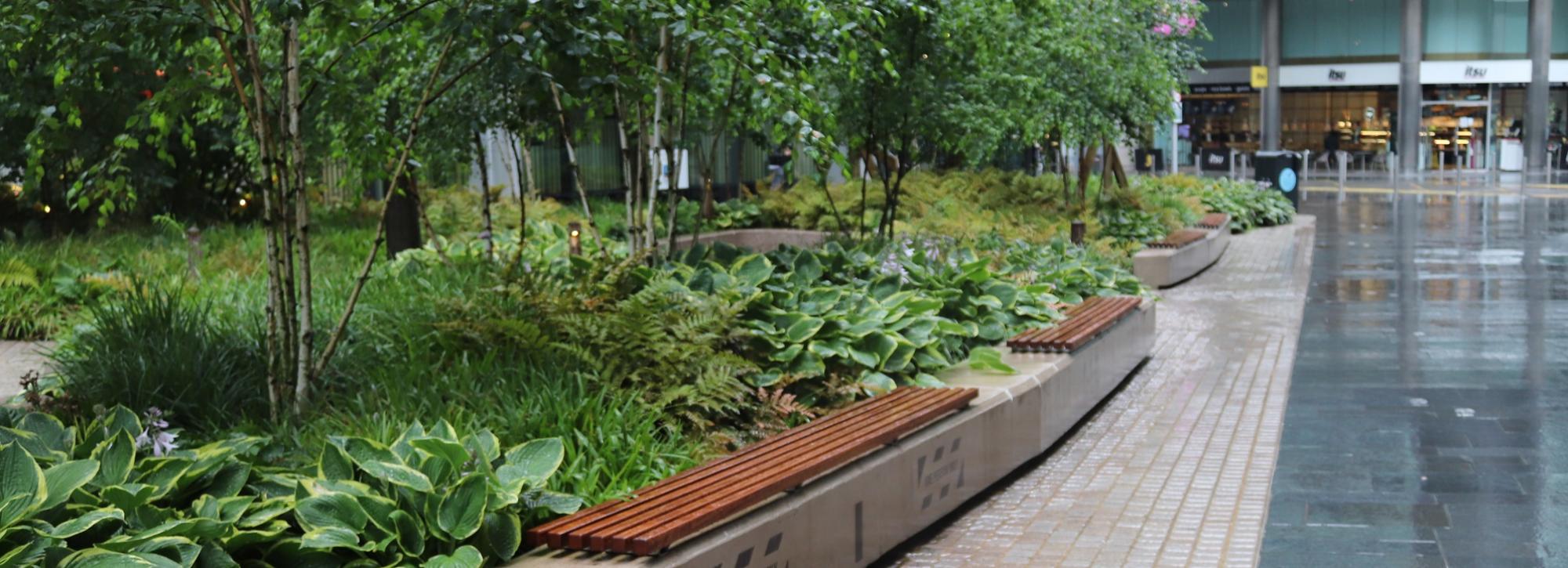
The future of our urban areas relies on blue-green infrastructure
The Environment Agency’s report ‘The state of the environment: the urban environment’ concludes that the integration of urban green and blue space is key to helping address many of the challenges and in generating important benefits for our future towns and cities. In this article, Bridget Woods-Ballard explains why the integration of nature-based surface water management systems are becoming ever more important.
Nature-based surface water management systems not only help manage flood risk in urban areas, but can also make a significant contribution to improving people’s mental health and wellbeing, and reversing habitat degradation in urban environments. As our climate and ecological emergencies accelerate, drainage engineers have a crucial role to play in supporting the design of surface water management systems that deliver high value blue-green infrastructure throughout new development and re-development.
The coronavirus pandemic has highlighted the importance of access to high quality public spaces, not just for people’s enjoyment, but as a crucial influence on people’s mental health. In parallel, climate and ecological emergencies are becoming increasingly critical. It is clear we need to take urgent action to protect the environment, make urban areas more liveable and climate resilient, and drive step changes in biodiversity protection and enhancement. Integrating blue-green infrastructure throughout development is one of the key actions that must be facilitated and accelerated. Only by moving away from traditional underground pipe and storage networks and embracing the use of more sustainable approaches to the management of runoff from rainfall will we be maximising, rather than wasting, the value of this precious resource.
Blue-green infrastructure embraces the concept of water sensitive urban design, which is exemplified by China’s ‘sponge cities’. In other parts of the world, these concepts are also known as sustainable drainage, best management practices and low impact development. The benefits are manifold: managing flood risk, mitigating the environmental impact of new development, creating and restoring essential natural spaces and habitat, and climate-proofing urban life.
Blue-green systems focus on:
- capturing and harvesting rainfall, an increasingly vital tool for water scarce environments.
- encouraging the infiltration and evapotranspiration of a large proportion of annual rainfall to support natural catchment hydrology, groundwater replenishment, and soil and ecosystem health; and to reduce contributions to combined sewer spills.
- slowing and storing flows to reduce downstream flood risks (in both natural and sewered catchments) and minimise morphological and ecological damage to urban watercourses.
- naturally filtering and cleansing runoff that carries urban pollutants before it enters our natural environments.
As our climate patterns shift, rising rainfall intensities along with increasing urbanisation has led to surface water flood risk escalating – and increasing the capacity of subsurface pipework does not provide the best cost-benefits. By reducing volumes and rates of runoff into sewers, the frequency of sewer spills can be reduced and sewer capacity and headroom can be protected for future generations.
But the benefits of using blue-green infrastructure to deliver our surface water management extend far further than the purely hydrological. Increasing urban green and blue space helps to create new habitats and ecological corridors – to the benefit of biodiversity. It can also help offset rising temperatures and improve roadside air quality. Furthermore, the social benefits of green and blue public spaces for people in our cities have been robustly established – they encourage health, wellbeing and community spirit.
One important point in delivering the multiple benefits that sustainable drainage systems (SuDS) can offer is to make sure they are considered at an early stage of the design process. There is a clear need for water to be a central focus of masterplanning so that high value blue-green infrastructure can be integrated throughout the fabric of the development and its landscape.
We also believe that having the right standards and guidance in place can make a huge difference. We have recently completed research for the Department for Environment, Food and Rural Affairs (Defra) looking at how updating England’s standards for SuDS could support the delivery of those multiple benefits. While our research focused on England, the principles could be applied elsewhere.
Engagement with stakeholders suggested that they would welcome modifications to the standards, along with supporting guidance and recommended tools. Our recommendations to Defra are to have a new suite of six standards covering runoff destination, everyday rainfall, extreme rainfall, water quality, amenity and biodiversity. We also recommended that other relevant national policy and guidance references are aligned with the objectives and requirements of the standards to maximise outcome value.
Our blue-green portfolio
At HR Wallingford, we have extensive experience in using natural systems to manage flood risk. In the UK, we are supporting the urban design industry in moving towards more sustainable approaches to drainage – drafting standards and guidance, undertaking research, promoting free design tools (such as www.uksuds.com) and delivering regular on-line training courses.
Our research studies in the UK and overseas have shown the extent to which blue-green infrastructure solutions can be retrofitted within the urban fabric to relieve capacity in receiving sewers. As part of this research, we optimised risk reduction strategies by identifying areas with high associated hydraulic loads (‘hazard mapping’) in combination with ‘risk mapping’ of surcharge points and mapping of areas that could potentially be retrofitted with surface water infiltration and storage. We are currently working with IGNITION partners in Greater Manchester to evaluate potential benefits of retrofit blue-green infrastructure for sewer capacity. ‘IGNITION’s projects in and around Greater Manchester are providing data that will help develop investable propositions for urban resilience, for public goods and for nature-based solutions to the climate emergency’ (Emma Howard Boyd, Chair of the Environment Agency, July 2021)
In China, our drainage engineers are modelling, designing and delivering research for sponge cities, which are the blueprint for new development across the country. We undertook cutting-edge research for Xiamen, one of the first 16 sponge pilot cities in China. The project tested four different types of SuDS components: a bioretention cell, a permeable pavement, a green roof, and a vegetated swale. Components were characterised by a set of input parameters, and tested under design rainfall intensities. The research enabled designers to focus site testing resources on SuDS components that provided the greatest benefits.
As cities worldwide grapple with the effects of a changing climate, blue-green infrastructure will become increasingly important. Water sensitive design in our cities remains novel and there are many lessons to be learned, shared and put into practice. However, as green infrastructure becomes the norm for surface water management, our expertise and understanding as drainage engineers will be fundamental in helping cities worldwide deliver valuable, functional and resilient urban environments.
Want to know more?
